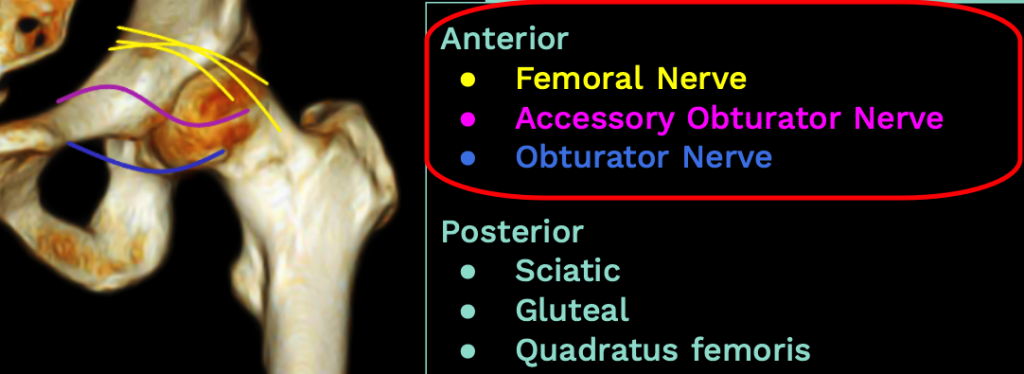Background
Hip fractures are a very frequent presentation, even in non trauma centers.
Usually affects senior patients with comorbidities, and it’s associated with high morbidity and mortality.
Adequate pain control, and early surgical treatment and mobilization are the main goals of hip fracture treatment; to reduce complications including infections, DVT and delirium.
The AAOS states that “Multimodal analgesia incorporating pre-operative nerve blocks is recommended to treat pain after a hip fracture”
The Pericapsular Nerve Group Bbock (PENG block) is a novel approach to provide analgesia to the hip joint without affecting the motor function of the quadriceps muscle or altering the sensory exam.
The PENG block targets the small rami from the femoral, obturator and accessory obturator nerve on their way to the hip joint (while passing underneath the psoas tendon), and after they have already branched their sensory and motor rami.

Indications
- Intertrochanteric fractures
- Femoral neck fractures
- Acetabular fractures
- Pubic ramus fractures
- Hip dislocations
The PENG block is not effective for injuries below the IT line; for this go for a block instead.
Anatomic Landmarks
Using a curvilinear probe parallel to the inguinal crease, identify the femoral head. The formal head looks like a rounded hyperechogenic structure. Sliding and tilting the probe slightly up (towards cephalic), identify the pelvic rim (ilium). In between the IPE (iliopubic eminence, medial) and AIIS (anterior inferior iliac spine, lateral) lies the psoas tendon, covered by the iliacus muscle. Your target is the virtual space underneath the psoas tendon.

In-plane approach
Using a 20-21G echogenic nerve block needle or a spinal needle (Quincke), enter the skin from the lateral end of the probe. The needle has to be perfectly aligned with the probe (that is aligned with your target). You should be able to visualize the full length of the needle shaft and tip. Approach the psoas tendon on its lateral side and advance the needle until you hit the bone.


Inject saline to improve your view, and confirm that the psoas tendon is lifting up from the bone (you might have to withdraw the needle 1-2 mm if it’s hard to inject). Once you confirm the position and opening of this space, inject at least 20cc of the local anesthetic.
Materials
- To perform an aseptic procedure: Examination gloves, probe cover, individual gel package, antiseptic to clean up the skin.
- Needle: echogenic atraumatic nerve block needle 20-21 G, or Quincke spinal needle
- Connection: extension IV tubing, 3-way stopcock, saline flushes
- Local anesthetic: at least 20cc of volume. Bupivacaine with epinephrine is longer lasting and decreases the risk of systemic toxicity. Calculate the dose for your patient’s weight and comorbidities. SafeLocal app
Special thanks to Dr. Ben Asriel for being a perfect model.
Sabrina Rodera Zorita
